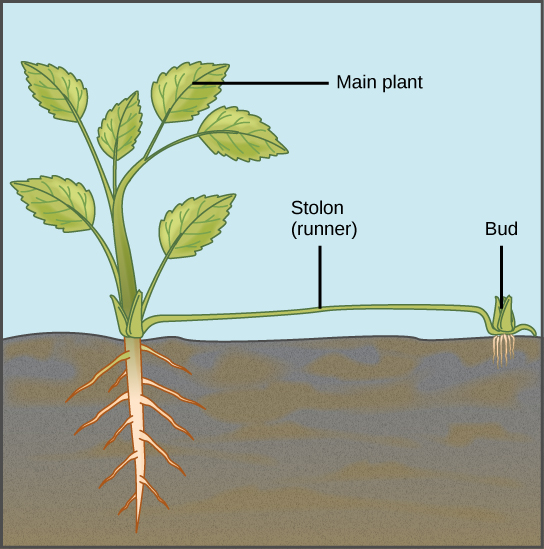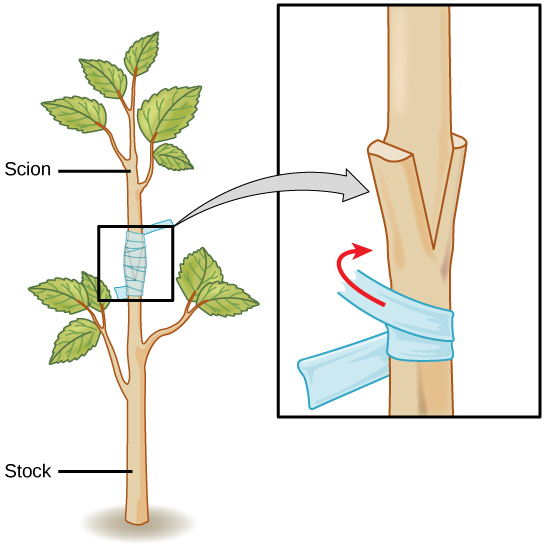Asexual Reproduction in Plants
Plants can reproduce asexually, without the fertilization of gametes, by either vegetative reproduction or apomixis.
Natural Methods of Asexual Reproduction
Natural methods of asexual reproduction include strategies that plants have developed to self-propagate. Many plants, such as ginger, onion, gladioli, and dahlia, continue to grow from buds that are present on the surface of the stem. In some plants, such as the sweet potato, adventitious roots or runners (stolons) can give rise to new plants. In Bryophyllum and kalanchoe, the leaves have small buds on their margins. When these are detached from the plant, they grow into independent plants; they may also start growing into independent plants if the leaf touches the soil. Some plants can be propagated through cuttings alone.

Runners: asexual reproduction: A stolon, or runner, is a stem that runs along the ground. At the nodes, it forms adventitious roots and buds that grow into a new plant.
Artificial Methods of Asexual Reproduction
Artificial methods of asexual reproduction are frequently employed to give rise to new, and sometimes novel, plants. They include grafting, cutting, layering, and micropropagation.
Grafting
Grafting has long been used to produce novel varieties of roses, citrus species, and other plants. In grafting, two plant species are used: part of the stem of the desirable plant is grafted onto a rooted plant called the stock. The part that is grafted or attached is called the scion. Both are cut at an oblique angle (any angle other than a right angle), placed in close contact with each other, and are then held together. Matching up these two surfaces as closely as possible is extremely important because these will be holding the plant together. The vascular systems of the two plants grow and fuse, forming a graft. After a period of time, the scion starts producing shoots, eventually bearing flowers and fruits. Grafting is widely used in viticulture (grape growing) and the citrus industry. Scions capable of producing a particular fruit variety are grafted onto root stock with specific resistance to disease.

Grafting: Grafting is an artificial method of asexual reproduction used to produce plants combining favorable stem characteristics with favorable root characteristics.
Cutting
Plants such as coleus and money plant are propagated through stem cuttings where a portion of the stem containing nodes and internodes is placed in moist soil and allowed to root. In some species, stems can start producing a root even when placed only in water. For example, leaves of the African violet will root if kept undisturbed in water for several weeks.
Layering
Layering is a method in which a stem attached to the plant is bent and covered with soil. Young stems that can be bent easily without any injury are the preferred plant for this method. Jasmine and bougainvillea (paper flower) can be propagated this way. In some plants, a modified form of layering known as air layering is employed. A portion of the bark or outermost covering of the stem is removed and covered with moss, which is then taped. Some gardeners also apply rooting hormone. After some time, roots will appear; this portion of the plant can be removed and transplanted into a separate pot.

Layering: In layering, a part of the stem is buried so that it forms a new plant.
Micropropagation
Micropropagation (also called plant tissue culture) is a method of propagating a large number of plants from a single plant in a short time under laboratory conditions. This method allows propagation of rare, endangered species that may be difficult to grow under natural conditions, are economically important, or are in demand as disease-free plants.
To start plant tissue culture, a part of the plant such as a stem, leaf, embryo, anther, or seed can be used. The plant material is thoroughly sterilized using a combination of chemical treatments standardized for that species. Under sterile conditions, the plant material is placed on a plant tissue culture medium that contains all the minerals, vitamins, and hormones required by the plant. The plant part often gives rise to an undifferentiated mass, known as a callus, from which, after a period of time, individual plantlets begin to grow. These can be separated; they are first grown under greenhouse conditions before they are moved to field conditions.
Courtesy:- Lumen Learning





